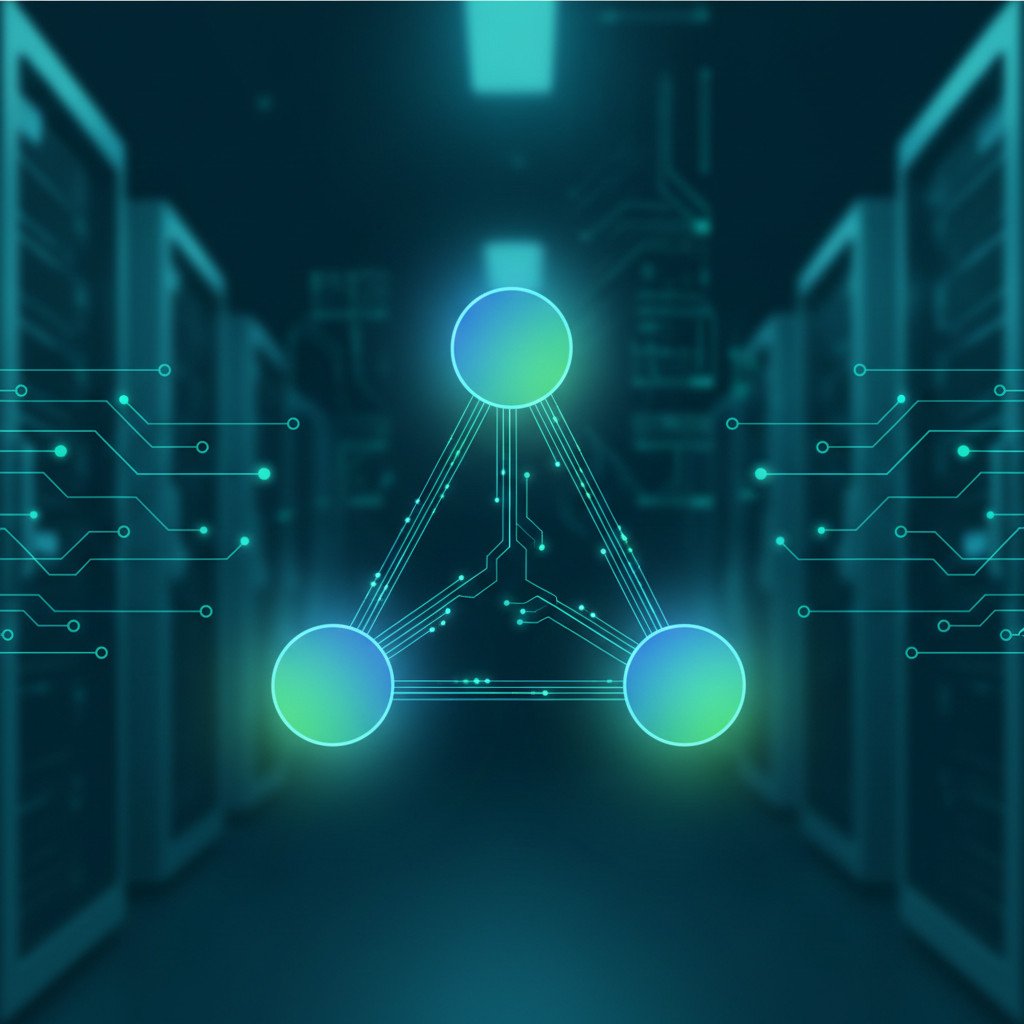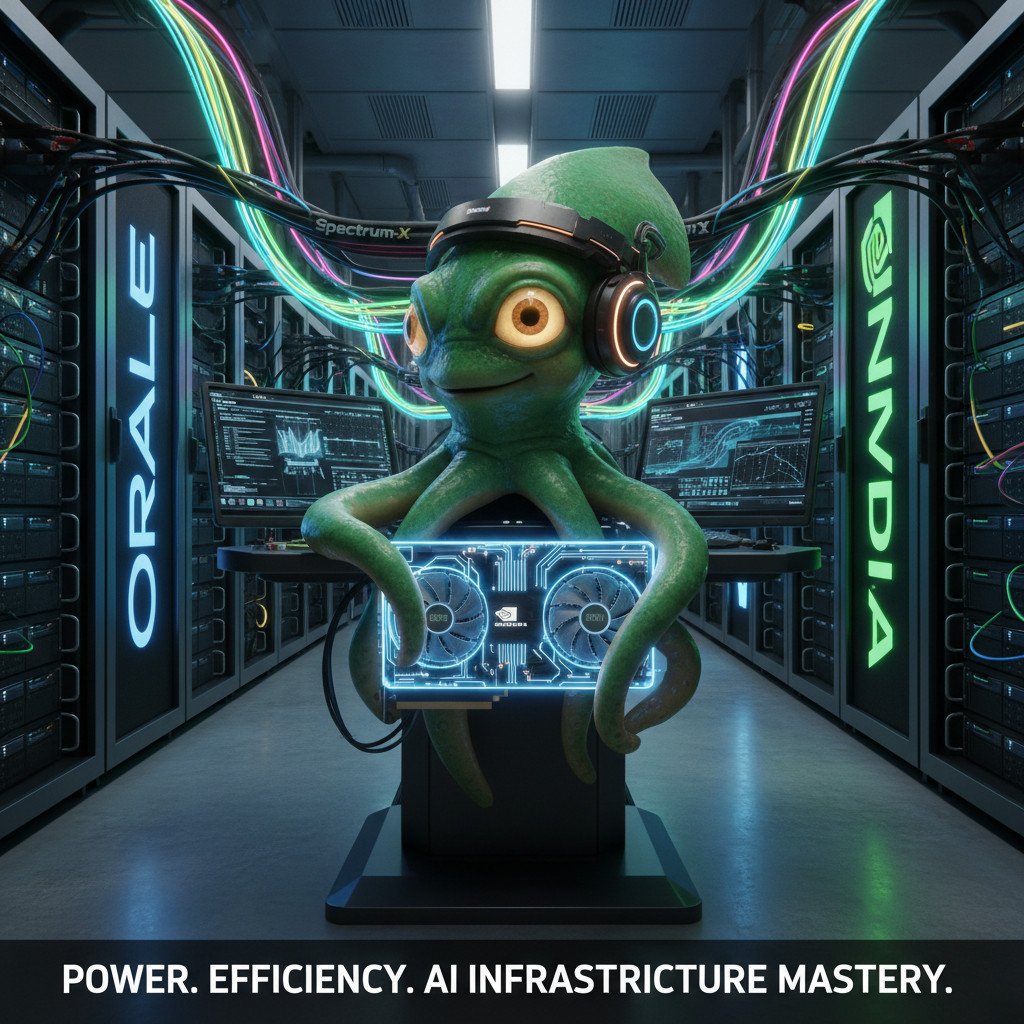NVIDIA Spectrum-X powers enterprise AI data centers with Oracle and Meta partnerships, delivering high-performance Ethernet tailored for GPU clusters. Because GPUs wait less for data, training scales faster and cost per model drops.
Moreover, Spectrum-X uses adaptive routing and telemetry-based congestion control to reduce hotspots and maximize link efficiency. Therefore, through deep integrations with Oracle such as native NVIDIA AI Enterprise on OCI, Oracle AI Database 26ai, and GPU offloads for vector embeddings—alongside Meta’s FBOSS contributions and scale-tested designs—organizations can build MGX racks and Zettascale deployments that connect NVLink scale-up with Spectrum-X scale-out for production AI pipelines and multi-site training.
As a result, enterprises gain near 95 percent effective bandwidth for AI workloads, reduced hotspot congestion, and higher GPU utilization, and they can pair Spectrum-X with Oracle’s AI tools to run RAG workflows, NIM microservices, and NeMo Retriever directly on OCI; this lets teams deploy inference and agentic AI at scale while maintaining data security, operational simplicity, and reliability.

NVIDIA Spectrum-X powers enterprise AI data centers with Oracle and Meta partnerships: technology overview
Spectrum-X is NVIDIA’s purpose-built Ethernet stack for AI workloads. It combines specialized silicon, next-generation DPUs, and software to remove networking bottlenecks. Because GPUs often sit idle waiting for data, Spectrum-X focuses on predictable, low-latency delivery. As a result, organizations can scale from single racks to multi-site Zettascale clusters without losing GPU efficiency.
Key components and capabilities
- Spectrum-4 switches deliver high-throughput, low-latency switching with telemetry-based congestion control. This adaptive routing reduces hotspots and balances flows across fabric. Therefore, effective bandwidth approaches 95 percent for many AI patterns.
- BlueField DPUs and SmartNICs offload networking and storage tasks from CPUs. In addition, the DPUs accelerate in-network processing and secure telemetry. This offload frees CPU cycles and shortens data paths to GPUs.
- Software and telemetry include advanced congestion control, flow learning, and programmable pipelines. Moreover, these tools provide the per-flow visibility needed to tune AI training jobs.
How Spectrum-X improves enterprise AI data centers
Spectrum-X aligns networking with GPU behavior. Because it uses fine-grained telemetry and adaptive routing, it prevents single-flow congestion. Therefore training jobs show higher GPU utilization and steadier throughput. In practical terms, MGX racks that pair NVLink scale-up with Spectrum-X scale-out can run large parallel training jobs more efficiently. For design guidance, NVIDIA’s Spectrum-X platform page outlines architecture and component choices and is a useful reference for architects.
Interoperability and ecosystem integrations
Spectrum-X supports open networking APIs and works with software like Meta’s FBOSS designs. As a result, hyperscalers can standardize racks and switch fabrics for long-term reuse. Moreover, Oracle’s AI stack, including Oracle AI Database 26ai and native NVIDIA AI Enterprise on OCI, integrates with Spectrum-X for end-to-end AI pipelines. For enterprise teams, the Oracle announcement explains how database AI features and GPU offloads link directly into accelerated networks.
Practical outcomes and deployment notes
Deployers can expect higher sustained throughput and fewer tail-latency spikes. In addition, Spectrum-X reduces wasted GPU cycles and lowers model training costs per parameter. However, operators should plan for power density, MGX modularity, and NVLink topologies. Finally, Spectrum-X acts as the network nervous system for giga-scale AI, enabling RAG, NeMo Retriever, and NIM microservices to run reliably at scale.
Related keywords and concepts: Spectrum-X Ethernet, Spectrum-4, BlueField DPU, telemetry-based congestion control, MGX racks, NVLink, OCI Zettascale10, Unified Hybrid Vector Search, RAG, NIM microservices, NeMo Retriever.
Comparison: NVIDIA Spectrum-X powers enterprise AI data centers with Oracle and Meta partnerships versus alternatives
| Solution | Purpose-built for AI | Effective bandwidth and latency | Congestion control and telemetry | DPU or offload support | NVLink and GPU scale-up compatibility | Ecosystem partnerships and integrations | Best fit use cases | Notes on maturity |
|---|---|---|---|---|---|---|---|---|
| NVIDIA Spectrum-X | Yes; built for GPU fabrics | Very high; up to 95 percent effective bandwidth | Advanced adaptive routing and telemetry-based congestion control; minimizes hotspots | BlueField DPUs and SmartNIC offloads | Designed to pair with NVLink within MGX racks | Deep ties to Oracle and Meta; integrates with OCI, FBOSS, NeMo Retriever | Large-scale training, multi-site AI clusters, RAG at scale | New generation; purpose-designed for AI fabrics |
| InfiniBand HDR / HDR100 | Originally optimized for HPC and AI | Very low latency; high throughput for tightly-coupled jobs | Congestion control varies; hardware-level QoS | Native offloads in HCAs; low CPU overhead | Common in NVLink-connected GPU clusters | Widely supported by HPC vendors and ISVs | HPC training, synchronous distributed training | Mature and proven in supercomputing |
| RoCE v2 Ethernet (Arista, Cumulus) | General Ethernet adapted for AI | High, but sensitive to fabric tuning | Depends on RDMA and PFC; requires careful tuning | SmartNICs available for offload | Works with NVLink racks but needs careful topology | Broad vendor ecosystem; open networking options | Cost-effective data-center AI where Ethernet standardization matters | Mature, but operational complexity can rise |
| Cisco ACI and Nexus AI fabrics | Enterprise Ethernet with AI optimizations | High; enterprise QoS and latency controls | Integrated telemetry; software-driven controls | Support for SmartNICs and offload modules | Compatible with NVLink with validated designs | Strong enterprise partnerships, managed services | Enterprise AI, mixed workloads, regulated environments | Enterprise-grade support and tooling |
| Hyperscaler open fabrics (FBOSS, SONiC) | Customizable for scale and operator needs | Tunable; designed for hyperscale consistency | Software-driven telemetry and flow control | Often paired with programmable NICs | Designed to integrate with NVLink in hyperscale racks | Used by Meta, Microsoft, others; open-source stacks | Hyperscale training, custom NOS deployments | Very scalable; requires operator expertise |
Notes
- Because Spectrum-X targets GPU-centric traffic patterns, it prioritizes per-flow visibility and adaptive routing. Therefore, it reduces wasted GPU cycles during training jobs.
- However, InfiniBand remains a strong choice for very latency-sensitive, tightly-coupled HPC workloads.
- For enterprises, RoCE and vendor fabrics offer familiar operational models. In addition, open fabrics give hyperscalers flexibility.
Related concepts: Spectrum-4, BlueField DPU, MGX racks, NVLink, telemetry-based congestion control, RoCE, FBOSS, SONiC.
NVIDIA Spectrum-X powers enterprise AI data centers with Oracle and Meta partnerships
NVIDIA’s Spectrum-X strategy pairs cutting-edge Ethernet with deep partner integrations. Because enterprise AI demands both high bandwidth and predictable latency, NVIDIA works closely with Oracle and Meta. As a result, these collaborations accelerate real-world AI workloads. Therefore, enterprises gain a networking stack designed for GPU-heavy training and inference.
Oracle partnership: systems, database, and cloud integration
Oracle and NVIDIA align hardware and software to speed AI pipelines. For example, OCI Zettascale10 ties NVIDIA GPUs to Spectrum-X fabrics, giving customers massive scale and performance. In addition, Oracle AI Database 26ai and native NVIDIA AI Enterprise on OCI streamline model training and inference. You can read Oracle’s announcement about Zettascale10 for technical details and deployment guidance. Moreover, NVIDIA and Oracle jointly enable GPU offloads for vector embeddings, using libraries such as cuVS to move work close to the accelerator.
Meta partnership: open networking and scale-tested fabrics
Meta contributes production-hardened switch software and designs that validate Spectrum-X at hyperscale. For instance, Meta’s FBOSS project provides an open switching environment for custom NOS stacks. Therefore, Spectrum-X benefits from FBOSS integration and real-world testing. In addition, Meta’s operational learnings influence MGX rack layouts and NVLink topologies. You can explore FBOSS on GitHub to understand Meta’s open networking approach.
How the partnerships create competitive advantages
Together, these alliances deliver end-to-end advantages across hardware, software, and operations. Because Oracle stitches database AI into the network, RAG workflows and Unified Hybrid Vector Search run closer to GPUs. Consequently, teams see fewer data movements and lower inference latency. Meanwhile, Meta’s FBOSS expertise helps Spectrum-X avoid hotspots at hyperscale. Therefore, organizations can scale to multi-site training with predictable performance.
Operational and deployment considerations
Operators should plan power, rack density, and NVLink interconnects when deploying Spectrum-X at scale. Moreover, MGX modular racks reduce upgrade costs while supporting Spectrum-X fabrics. In addition, telemetry-based congestion control gives operators visibility to tune jobs. However, teams must align software stacks and orchestration tooling for optimal throughput.
Bottom line
The Oracle and Meta partnerships make Spectrum-X more than an Ethernet product. Instead, they create an integrated platform for enterprise AI. Consequently, customers get higher GPU utilization, simplified AI database pipelines, and a validated path to giga-scale model training.

Benefits and business impact of NVIDIA Spectrum-X in AI data centers
NVIDIA Spectrum-X powers enterprise AI data centers with Oracle and Meta partnerships and delivers measurable business benefits. Because Spectrum-X aligns networking with GPU behavior, teams get higher utilization and lower model costs. Therefore, IT and data leaders can justify upgrades with clearer ROI and faster time to insight.
Key benefits and business impacts
- Improved GPU utilization and lower training cost per model. Because Spectrum-X reduces hotspots and stalls, GPUs run longer at full capacity. As a result, organisations cut wasted compute and lower per‑parameter training cost.
- Predictable performance at scale. Moreover, adaptive routing and telemetry-based congestion control maintain steady throughput across many GPUs. Therefore, multi-site training and Zettascale deployments remain reliable under heavy load.
- Faster data‑to‑model cycles. In addition, closer integration with database AI and GPU offloads reduces data movement. For more technical details, see NVIDIA’s Spectrum-X product page.
- Simplified AI pipelines and database integration. Because Oracle AI Database 26ai and native NVIDIA AI Enterprise on OCI interoperate with Spectrum-X, teams can run RAG and agentic AI workflows closer to GPUs. Consequently, inference latency drops and developers iterate faster. See Oracle’s Zettascale announcement for context.
- Hyperscale operational learnings and open networking. Meta’s FBOSS contributions help validate Spectrum-X in real environments. Therefore, operators gain tested NOS patterns and rack designs. You can explore FBOSS on GitHub to learn more.
- Lower total cost of ownership. Because Spectrum-X reduces idle GPU time and simplifies network tuning, operational costs fall. In addition, MGX modular racks help future‑proof investments across hardware generations.
- Better security and manageability. Finally, DPUs and software offloads allow in‑network telemetry and secure processing. As a result, teams isolate workloads and monitor flows without heavy CPU overhead.
Business outcomes to expect
- Shorter model development cycles and faster feature delivery. In addition, lower cloud and on-prem run costs improve project economics.
- Greater confidence for AI at scale, because the platform supports validated designs and partner integrations.
Related keywords and concepts: Spectrum-4, BlueField DPU, telemetry-based congestion control, MGX racks, NVLink, RAG, NeMo Retriever, Unified Hybrid Vector Search.
NVIDIA Spectrum-X powers enterprise AI data centers with Oracle and Meta partnerships: future trends and potential
AI data centers will evolve into integrated compute, network, and data platforms. Because Spectrum-X unifies Ethernet, DPUs, and telemetry, it sets a new foundation. Therefore, networks will act more like compute resources than simple pipes.
Expect more in-network computing and DPUs at scale. In addition, BlueField DPUs will run secure services, telemetry, and lightweight AI functions. For technical context, NVIDIA’s Spectrum-X product page details the stack and capabilities.
Hybrid and multi-site AI will become routine. Consequently, fabrics that link MGX racks across regions will power synchronous and asynchronous training. Oracle’s OCI Zettascale10 announcement shows how Oracle and NVIDIA plan multi‑site zettascale clusters with Spectrum-X fabrics.
Memory and storage disaggregation will accelerate AI workflows. Moreover, telemetry-driven adaptive routing will reduce costly data movement. As a result, teams will place data and model shards where latency and throughput meet workloads.
Open networking and software ecosystems will guide standardisation. Meta’s FBOSS project demonstrates production-proven switch software and operational patterns. Therefore, Spectrum-X will benefit from open NOSs, validated configurations, and real-world scale testing.
Security and compliance will move into the fabric. Because Oracle adds quantum-resistant algorithms and in-database agentic AI, data protection requirements will shape network design. Thus DPUs will host encryption and secure key management close to data flows.
AI lifecycle automation will rely on network-aware orchestration. In addition, telemetry feeds will drive job schedulers and placement engines. Consequently, model training will start, migrate, and resume with fewer manual steps.
Energy and power innovations will match compute density. For example, 800‑volt DC power and power-smoothing technologies will reduce spikes and increase usable capacity. Therefore, data centers can pack more GPUs per rack without compromising reliability.
Bottom line
Looking ahead, Spectrum-X plus Oracle and Meta integrations will enable next-generation AI. As a result, enterprises can run larger models, shorten iteration cycles, and deploy agentic AI with predictable performance.
Key takeaways: NVIDIA Spectrum-X powers enterprise AI data centers with Oracle and Meta partnerships
| Topic | Summary | Business impact | Related keywords and notes |
|---|---|---|---|
| Core technology | Spectrum-4 switches, BlueField DPUs, adaptive routing, and telemetry-based congestion control. Because these components work together, networks serve GPU patterns efficiently. | Up to 95 percent effective bandwidth, fewer hotspots, and higher GPU utilization. Therefore training and inference run faster. | Spectrum-X Ethernet, Spectrum-4, BlueField DPU, telemetry-based congestion control |
| Oracle integration | OCI Zettascale10, Oracle AI Database 26ai, native NVIDIA AI Enterprise on OCI, and GPU offloads for vector embeddings. Moreover, Oracle ties database AI into the compute fabric. | Simplified AI pipelines, reduced data movement, faster RAG and agentic AI workflows. Consequently teams lower inference latency and speed iteration. | Oracle AI Database 26ai, cuVS, NVIDIA AI Enterprise, OCI Zettascale10 |
| Meta collaboration | FBOSS production-hardened switch software, validated hyperscale rack designs, MGX rack learnings. As a result, Spectrum-X benefits from real-world scale testing. | Production-proven NOS patterns, easier hyperscale deployments, predictable behaviour at scale. Therefore operators can scale multi-site clusters. | FBOSS, open networking, MGX racks, NVLink topology |
| Competitive positioning | Purpose-built for GPU fabrics versus general-purpose Ethernet and legacy HPC interconnects. However InfiniBand remains strong for ultra-low latency HPC. | Better return on GPU investments, lower cost per parameter, and clearer ROI for enterprise AI projects. | RoCE, InfiniBand, enterprise Ethernet comparisons |
| Operational considerations | Plan for power density, NVLink interconnects, MGX modularity, and DPU-based telemetry. In addition, integrate orchestration and job placement tools with network telemetry. | Reduced tail latency, better job placement, and lower operational overhead. Therefore deployments scale more predictably. | NVLink, 800V DC power, power-smoothing technology, orchestration tools |
| Future trends | In-network computing with DPUs, hybrid multi-site fabrics, memory disaggregation, fabric-level security, and network-aware AI lifecycle automation. | Enables giga-scale models, faster data-to-model cycles, and agentic AI at enterprise scale. Consequently organisations can innovate faster. | Vera Rubin, Rubin CPX, Unified Hybrid Vector Search, NeMo Retriever |
Notes: This table summarises technology features, partnership highlights, deployment notes, business benefits, and future trends. Use it to guide architecture and procurement decisions for enterprise AI.
Conclusion
NVIDIA Spectrum-X powers enterprise AI data centers with Oracle and Meta partnerships and redefines how organisations scale GPU-driven workloads. Because Spectrum-X aligns networking, DPUs, and telemetry with GPU behavior, it unlocks higher utilization and steady performance. Therefore, teams shorten model training cycles and reduce cost per parameter. In addition, Oracle’s database integrations and Meta’s production-hardened networking designs make the platform practical for enterprise deployment.
For business leaders, the message is simple. Deploying Spectrum-X delivers measurable ROI through faster time to insight and lower operational waste. Moreover, the combined platform supports modern patterns such as RAG, agentic AI in databases, and multi-site Zettascale clusters. As a result, organisations can move from experimentation to production with greater confidence.
EMP0 (Employee Number Zero, LLC) helps companies capture these advantages through AI and automation solutions focused on growth. EMP0 builds AI-powered sales and marketing automation systems that accelerate pipeline creation and nurture. In addition, EMP0 integrates data pipelines, orchestration, and agentic workflows so teams scale revenue operations. Because EMP0 combines technical know-how with practical automation playbooks, clients see faster adoption of AI tools and clearer business outcomes.
To learn more about EMP0 and how it supports AI-powered growth systems, visit emp0.com or explore their blog at articles.emp0.com. Follow their updates on @Emp0_com and on Medium at medium.com/@jharilela. EMP0 also publishes workflow templates on n8n.io at n8n.io/creators/jay-emp0.

